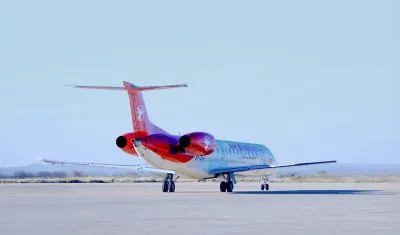The IMF’s annual Regional Economic Outlook: Sub-Saharan Africa report sees a bright future for Africa based on strong domestic growth and increased demand for Africa’s commodities. But it also warns against challenges that could derail growth.
According to the IMF’s Regional Economic Outlook: Sub-Saharan Africa (REO) report, economic growth in SSA has an optimistic future. Based on strong domestic demand, increased commodity prices and added value to exports, the region’s economies are collectively set to expand by 5.25% in 2011 and 5.75% in 2012.
These figures are enough to turn Europe and the US green with envy. The IMF predicts that the US economy will grow by only 1.8% in 2012 and the Eurozone only 1.1%. In the case of Europe, this projection has not taken into account the current dire debt situation in Greece and Italy and the impact this crisis could have on the euro and thus EU economies.
However, the report also warns Africa of the challenges ahead. Africa’s growth has come largely as a result of the increased international commerce across the region. The continent continued to rely on general global economic growth for its own prosperity.
The IMF says that Africa will only be able to sustain its growth trajectory “provided that global growth is sustained at the 4% mark in 2011 and 2012” and then only will “economic growth in sub-Saharan Africa remain fairly robust this year and next.”
This forecast is likely to force investors, many of whom deserted the continent during the financial crisis, to rethink their strategy on African frontier markets.
“We were very excited about Africa’s improvement,” said Mikiko Imai Ollison, one of the authors of the World Bank’s 2012 Doing Business report. He is referring to the fact that a record number of SSA nations have made significant changes to their business environments.
Four out of five (78%) of African governments improved their business climate and ease of doing business. Cape Verde was the champion climber, jumping a record 10 spots to 119th. Mauritius was the highest-ranked African country in 23rd place, followed by South Africa at 35th.
Low-income countries star
Perhaps the most encouraging trend spotted by the report is that the continent’s poorest countries are the most likely to show the greatest change. There has been a considerable rise in consumption even among the poorest households where the national economy has grown on the back of trade.
The region’s 26 low-income countries, which thus far have exhibited solid growth performance, will be the ones most likely to continue running at this pace.
Exceptions include Côte d’Ivoire, where a highly destructive civil war broke out after the 2010 presidential election – the first in 10 years. The incumbent, Laurent Gbagbo, refused to vacate office even though the polls indicated that his long-time rival, Alassane Ouattara had won. The conflict devastated the economy of this once prosperous West African country, the world’s largest producer of cocoa and an important exporter of fruits such as pineapples.
It is now classified in Africa’s low income category. Worse, it is dragging down the growth average of the category by a full percentage point. Including Côte d’Ivoire, the average projected growth for low-income countries is 5%; excluding Côte d’Ivoire, the projected average is 6%. Nevertheless, with new mining projects in Niger and Sierra Leone, the IMF expects growth for this category of countries to approach 7% in 2012.
The 11 middle-income countries in the region have lower growth prospects than their lower income counterparts, with an expected average growth of 4-4.5% in 2011 and 2012, a figure that still remains lower than before the global financial crisis.
A presumed slowdown in global growth is expected to have an impact on South Africa, one of the most internationally exposed countries on the continent, restraining its growth to 3.5% this year and in 2012.
Some countries have lower than expected growth rates. For instance Swaziland, Africa’s last monarchy, is undergoing a deepening fiscal and social crisis. The recession, which stemmed from the 2009 recession in South Africa, triggered a collapse in revenues from the Southern African Customs Union, which historically accounted for around two thirds of Swaziland’s budget; this has severely put pressure on both public and private spending.
Things are looking up in particular for resource-exporting countries, where strong commodity prices will fuel continued growth, improve terms of trade and increase foreign exchange reserves. Oil exporters are expected to grow by 6% in 2011 and 7% in 2012, above the regional average predicted.
Inflation woes
There is a clear warning in the regional outlook for an urgent need to tackle inflationary pressures with effective policy solutions. Consumer price inflation was around 10% in June against 7.5% in June 2010.
Already, in a quarter of the region’s economies, inflation has climbed to double digits. While inflation is mainly driven by rising food prices, there is also increasing non-food inflation caused by higher fuel bills and rising import costs. Inflation has started to place considerable pressure on exchange rates.
The IMF points to ‘worrying’ inflation rates in Kenya and Uganda, which have reached 16% and 20% respectively, caused by a combination of drought-induced food shortages and heightened global food and fuel prices. The report warns that this trend could damage the high economic growth of the region – Kenya is expected to grow a sizable 5.3% this year and 6.1% in 2012.
The report states that government should not be putting into effect monetary policy to deal with these shocks. So far, only a handful of countries have responded with monetary policy adjustments, although the IMF states that even these have not done so ‘decisively’ – interest rates remain little changed to what they were before the global financial meltdown.
Yet, in a riposte to the IMF report, the Central Bank of Kenya (CBK) was quick to respond early in November, by raising the Central Bank Rate (CBR) to 5.5% to reduce inflationary pressure and stabilise the shilling. In another measure aimed at limiting the amount of money in circulation, the Central Bank governor also said that the Cash Reserve Ratio (CRR), the money that commercial banks must keep with the Central Bank against their operations, would rise to 5.25%.
Domenico Fanizza, the head of the IMF mission in Kenya, says “Kenya needs to reduce the pace of the growth of private sector credit that is fuelling the rise in demand-pull inflation.” In September alone, private sector credit grew by 36% compared to the same month in 2010, a rate that was unsustainable.
New trade partners
Sub-Saharan Africa has considerably benefited from increased trade and investment with global and regional partners. These greater exchanges have brought gains from comparative advantage and economies of scale and are predicted to boost long-term growth by reducing output volatility. In the short term, however, some economists argue that it can actually increase output volatility.
The IMF report points out that this increased trade has mostly been a process of ‘trade creation’ and not ‘trade diversion’ – i.e. that trade increase is not about substituting old trade partners for new.
The region is increasingly looking towards non-traditional partners, and drastic change in the landscape has been happening at a considerable pace. Non-traditional partners now account for around 50% of sub-Saharan Africa’s exports and nearly 60% of imports. This is mostly driven by the important economies of Brazil, India and China, and also by trade with regional sub-Saharan partners.
In general, exports to the BRIC nations are largely limited to oil, gas and minerals; other emerging partners have far more diversified imports from Africa. Before the collapse of global oil prices in 2009, oil accounted for 70% of all of SSA exports to BRICs.
The link between sub-Saharan Africa and other emerging markets is much stronger than other regional blocs. Between 1990 and 2010, trade between developed countries in Europe, the US, Australia and New Zealand, Japan, Latin America, the Caribbean (LAC) and the Middle East and North Africa (MENA) fell by 14% and 19% respectively – the decline in sub-Saharan Africa was around 30%.
This increased distance from more ‘classic’ markets, shows the magnitude of business between sub-Saharan Africa and the emerging world. Further the IMF states that this is not solely oil-related trade, as many non-oil-exporting nations in the region are witnessing the same decline in trade with their DAC counterparts.
Sub-Saharan Africa is also increasingly focused on trading with its own regional partners, as intraregional trade now accounts for 14% of total trade, compared to only 7% back in 1990. South Africa is a significant generator for intraregional trade, accounting for 4% of total imports from sub-Saharan Africa and 6% of total exports.
Investment engine
It is not possible to discuss FDI into the region without mentioning China, whose FDI climbed from less than 1% in 2003 to a total of 16% in 2008, of all FDI into the region.
China’s investments are the most ‘geographically dispersed in the region’, especially when compared to Indian investments, which are mostly concentrated in Mauritius, and Brazil who has most investments going to Angola, Mozambique and Liberia. China is leaving a footprint in most sub-Saharan countries, although it is most heavily concentrated in South Africa, Nigeria, Zambia, Niger, Ethiopia and the Democratic Republic of Congo. Even though most Chinese investments in the region are directed towards natural resources and infrastructure, there has also been prominent investment in other sectors. An important example is the $5.4bn investment in a 20% stake in Africa’s Standard Bank by the Chinese Industrial and Commercial Bank.
China has also been establishing Special Economic Zones (SEZs) in the region, especially in manufacturing. These investments are usually colossal. For example, $5bn, (representing 2.3% of Nigeria’s GDP), has been invested in the first phase of the Nigerian Lekki Free Trade Zone, of which 60% is held by a Chinese developer and the remaining 40% by the local government.
Indeed, it seems that manufacturing has caught the eye of Chinese investors. Generally, large state-owned Chinese firms tend to focus on resources, whilst private firms tend to concentrate on manufacturing and service industries. In Ethiopia, with the largest population in Africa, Chinese investment is mainly driven by the presence of a market of 80m people – manufacturing thus takes up the largest amount of Chinese FDI.
In summary, while there is huge potential in the region’s economic growth, this is still dependent on the economic health of the global economy, a risk that the region needs to factor into its policies. Inflationary pressures, especially, need to be rigorously dealt with as this can seriously hamper good growth. Investment, especially domestically sourced, is vital.
Discussing investment risk, Graham Stock, chief strategist at Insparo Asset Management, an Africa and Middle East specialist, says investing in Africa less risky than investing in developed equity markets given the current volatility. “Risk is better priced in Africa than in developed markets and underlying fundamentals are stronger.” Who would have thought this could be said about Africa just a few years ago?
Want to continue reading? Subscribe today.
You've read all your free articles for this month! Subscribe now to enjoy full access to our content.
Digital Monthly
£8.00 / month
Receive full unlimited access to our articles, opinions, podcasts and more.
Digital Yearly
£70.00 / year
Our best value offer - save £26 and gain access to all of our digital content for an entire year!

 Sign in with Google
Sign in with Google 


